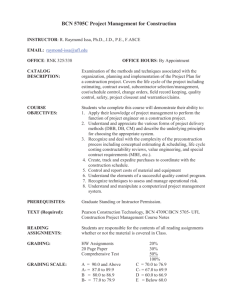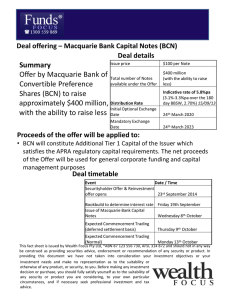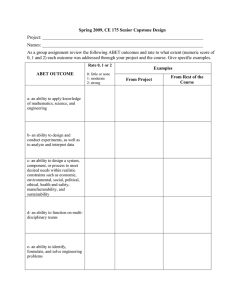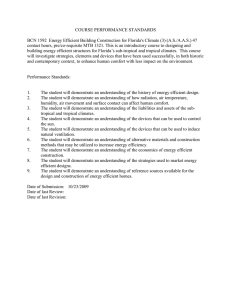The ABET Criteria: a. An ability to apply knowledge of mathematics
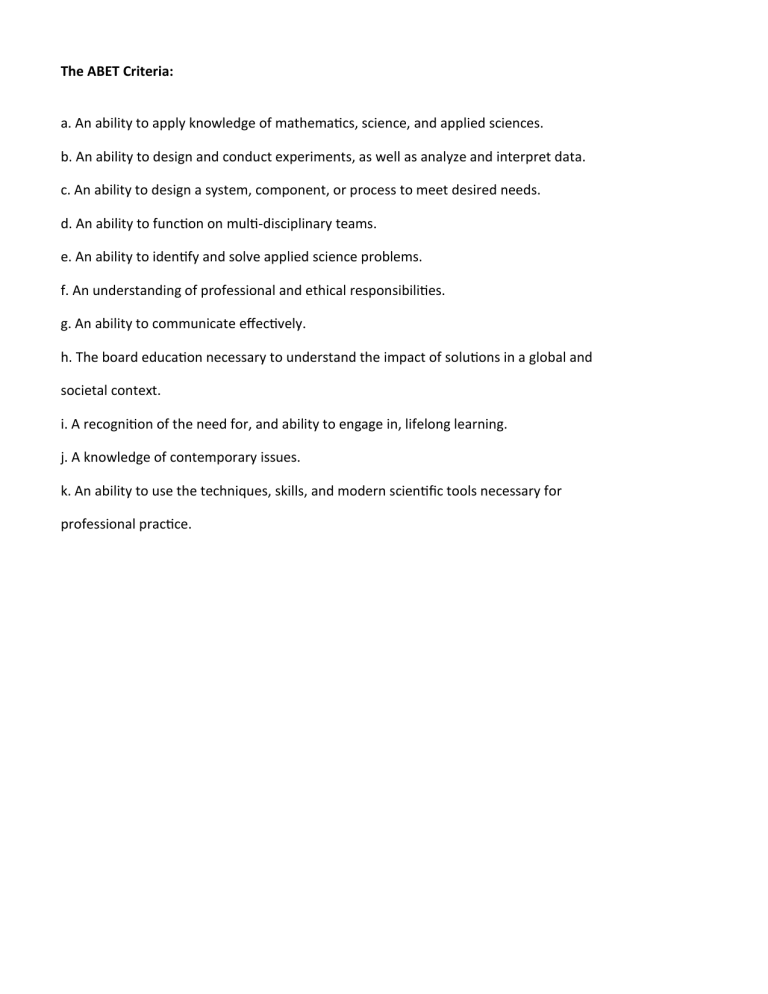
The ABET Criteria:
a. An ability to apply knowledge of mathematics, science, and applied sciences. b. An ability to design and conduct experiments, as well as analyze and interpret data. c. An ability to design a system, component, or process to meet desired needs. d. An ability to function on multi-disciplinary teams. e. An ability to identify and solve applied science problems. f. An understanding of professional and ethical responsibilities. g. An ability to communicate effectively. h. The board education necessary to understand the impact of solutions in a global and societal context. i. A recognition of the need for, and ability to engage in, lifelong learning. j. A knowledge of contemporary issues. k. An ability to use the techniques, skills, and modern scientific tools necessary for professional practice.
CM Course Student Outcomes & Their Relationship to ABET Criterion 3.
ABET Applied Science Criterion 3
BCN 1210c Construction Material
(a) (b) (c) (d) (e) (f) (g) (h) (i) (j) (k)
Understand the unique origins, chemistry, properties, standards, construction industry applications and trade organizations specific to the materials used in the construction industry. Materials include aggregates, cement, concrete, masonry, wood, steel, aluminum, asphalt, polymers, plastics and composites.
√
Design and execute laboratory experiments that test the physical properties of construction materials as √ √
√
Develop research and communication skills that will enable them to access technical information on materials, evaluate that information for quality, summarize findings concisely, and communicate those findings
√ √ √
BCN 1251 Construction Drawing
Knowledge of how to create and read construction drawings.
To be able to interpret construction drawings.
Attain ability to hand sketch.
Ability to work in a group and discuss/prepare construction drawings.
Understanding the different types of documentation including BIM.
BCN 2280 Survey: Construction Layout
Understand surveying and the technical aspects of surveying.
Construction ethics.
(a)
(a)
√
(b)
(b)
√
(c)
√ √
(c)
(d)
√
(d)
(e)
√
(e)
√
(f)
(f)
(g)
√
√
(g)
(h)
(h)
(i)
(i)
(j)
(j)
(k)
√
(k)
√
√
BCN 2405 Introduction to Structures
The student will upon successful completion of this course have a basic understanding of the nature of forces governing the design and behavior of materials and elements common to building construction.
BCN 3012 History of Construction
An understanding of quality control philosophies and techniques
Appreciation of the role of labor relations in construction projects
(a)
√
√
(a)
(b)
√
(b)
Knowledge of the parameters affecting project planning
Knowledge of the concepts and roles and responsibilities of project management.
Enhanced understanding and losses in labor, material and equipment unit costs.
Enhanced understanding of safe practices in construction practices.
√
(c)
(c)
(d)
(d)
(e)
√
(e)
(f)
(f)
(g)
(g)
√
(h)
(h)
√
(i)
(i)
(j)
(j)
√
√
√
(k)
√
(k)
CM Course Outcomes
BCN 3223 Soils & Foundations
Knowledge of soil failure and how to avoid it
Knowledge of basic mechanics of soil and its properties
Knowledge of water effects on soil density and soil strength.
Knowledge of soil investigation methods and information in soil reports.
Knowledge of soil strength and the variables that effect strength
Knowledge of soil compaction and how it is achieved.
Knowledge of Excavators, Dozers and Loaders, Scrapers, and Trucks and Wagons.
What effective oral communications are through the delivery of group presentations
Knowledge on ethics on soil and foundation related issues.
Familiar with the composition and properties, terminology and units of measure, standard designations, sizes and graduations, conformance references and testing techniques, equipment application and utilization, assembly techniques and equipment selection, and building codes and standards.
BCN 3224 Construction Techniques
To understand the people involved in design and construction, their roles, responsibilities, interaction and how to communicate with each other.
To become conversant in construction language.
To understand the purpose and uses of construction materials and systems.
To understand the way structures work, how forces are resisted and transferred and how materials and structural systems react to these forces.
To understand the processes used to set and achieve quality goals.
BCN 3611c Construction Cost Estimating
Understand direct cost and indirect cost on construction project cost such as contingencies, bond, etc.
Understand quantity take-off on main CSI divisions such as excavation, concrete, masonry, etc.
Understand the impact of labor productivity on project cost.
Understand how to organize bidding documents.
Understand on how to apply WinEst cost estimating software such as on-screen take off, worksheet preparation and summary sheet by CSI division.
Ethics in bidding a construction project.
ABET Applied Science Criterion 3
(a) (b) (c) (d) (e) (f) (g) (h) (i) (j) (k)
√
√
√
√
√
√
√ √
√ √
√
√
√
√
√
√
√
√
√
√
√
√ √
√
√
√
(a) (b) (c) (d) (e) (f) (g) (h) (i) (j) (k)
√
√ √
(a) (b) (c) (d) (e) (f) (g) (h) (i) (j) (k)
√
√
CM Course Outcomes ABET Applied Science Criterion 3
BCN 3762 Building Construction Design/Codes
Appreciation of the purpose and application of building codes in practice.
Have the ability to identify, define, and understand the terms and concepts related to building codes.
Knowledge and understanding the specific Florida building codes.
The ability to use the 2010 Florida Building Codes to search for regulations that apply to the design and construction of a structure.
Experience in working with others through team discussions and projects.
Enhanced personal communication skills, both oral and written.
Enhanced understanding and appreciation of ethical issues related to construction.
(a)
√
√
(b)
√
√
(c)
√
(d)
√
(e)
√
(f)
√
(g)
√
√
(h) (i) (j)
√
(k)
√
BCN 3782 Introduction to Construction Computing (a) (b) (c) (d) (e) (f) (g) (h) (i) (j) (k)
Knowledge of current and evolving technologies being used in the construction industry.
Knowledge of the relevant terminology and the resources available to aid in making informed decisions about incorporating technology into field and office applications.
Appreciation of the economic implication of incorporating new technologies in the workplace.
Basic technical skills in Excel, WinEst, P3, MS Project
2010 and ArchiCAD.
Enhanced computer literacy demonstrated through the completion of assignments.
Knowledge of the relevant technology and accounting practices for construction enterprises.
√
√
√
√
√
√
√
BCN 4240 Construction Equipment (a) (b) (c) (d) (e) (f) (g) (h) (i) (j) (k)
Class has not been taught yet.
(a) (b) (c) (d) (e) (f) (g) (h) (i) (j) (k) BCN 4431 Structural Systems
Bending forces that act on members in a structure.
Basic concepts of stress and strain in members.
How physical properties of materials differ and how that affects their performance.
Basic concepts of tension, compression, shear, bearing and bending stresses.
How temperature changes affect members.
Torsional stresses and deformation and the best types of cross-sections to resist twisting.
Shear forces and bending moments in beams.
√
√
√
√
√
√
√
√
√
√
√
√
√
√
√
√
√
√
√
√
√
√
√
√
√
√
√
√
√
√
√
√
√
√
√
CM Course Outcomes
BCN 4587c Green Const./Sustainability
Sustainability theories and impact on ethics in sustainable construction.
Components of LEED and Green Globes certification and assessment system.
Green building process, ecological design, alternative energy and environmental impact.
Sustainable water conservation methods and environmental impact.
LEED registered project reporting and recording requirements.
Integrated design process-creating high performance buildings
Building commission, life cycle costing of a high performance building.
LEED registered project documentation requirements, sustainable building practices.
BCN 4591c Mechanical & Electrical Systems
What constitutes human comfort as pertains to indoor climate and control.
The major design components affecting mechanical systems.
The major design components affecting electrical systems.
The basic fundamental operations and terminology of mechanical systems.
The basic fundamental operations and terminology of electrical systems.
The applications and utilization of equipment used in mechanical and electrical systems.
The assembly techniques and equipment selection in mechanical and electrical systems.
The applicable building codes and standards as pertaining to mechanical and electrical systems.
How ArchiCad BIM program can be used to design and place mechanical duct work, plumbing piping and electrical conduit in buildings.
ABET Applied Science Criterion 3
(a) (b) (c) (d) (e) (f) (g) (h) (i) (j) (k)
√
√
√
√
√
√
√
√
√
(a) (b) (c) (d) (e) (f) (g) (h) (i) (j) (k)
√
√
√
How ArchiCad BIM Eco module can be used to analyze
√
√
√
√
√
√
√
√
√
√
√
√
√
√
√
√
√
√
CM Course Outcomes
BCN 4612 Advance Cost Estimating
Describe types of estimates and uses.
Correctly apply labor and equipment productivity factors.
Understand pricing and price databases.
ABET Applied Science Criterion 3
(a) (b) (c) (d) (e) (f) (g) (h) (i) (j) (k)
√
√
√
Correctly apply job direct and indirect costs.
Understand proper bid preparation and submission.
Demonstrate correct expensing of capital equipment and depreciation.
Describe payment processes and time value of money.
Understand basic cost control data and procedures.
BCN 4708 Construction Documents/Contracts
Contract project documents, required management of the documents and resource allocation.
Fixed and variable costs of insurance, bonds, general and administrative expenses and their relationship to risk management.
Bidding, procurement, recording and reporting practices required by contract documents.
Construction contracts, components and the roles and responsibilities of the contract parties.
Contract regulatory environment including statutory and licensing requirements.
Mechanic liens and the rights of the contactor, second and third parties.
National and local labor laws, right to work laws, and union labor contracts.
Processes in resolving claims and disputes including mediation, arbitration and litigation.
Contract mandatory procedures such as training, record keeping and maintenance.
Roles and responsibilities of the contract parties in contract administration.
Labor relations in administrating union contractors on the job.
Procedures used in contract administration and execution.
Ethical conduct in contract administration and execution.
BCN 4709 Construction Management Capstone
The senior student CM capstone experience is based on cumulative knowledge and skills gained from the Program of Study. The course is designed with the contractor’s perspective and covers all stages of a construction project from project selection to project close-out.
Members of the construction industry participate with the instructor in defining the project and grading the team results. The seniors are also required to demonstrate their proficiency by taking an exam offered by the
AIC or the Florida Contractor’s exam.
√
√ √
√
(a) (b) (c) (d) (e) (f) (g) (h) (i) (j) (k)
√ √
√
√
√
√
√
√
√
√
(a) (b) (c) (d) (e) (f) (g) (h) (i) (j) (k)
√ √ √ √
√
√
√
√
√
√
√ √ √
√
√
√
CM Course Outcomes
BCN 4720 Construction Scheduling
Bar chart scheduling methods.
Develop a basic network.
Critical path method.
Precedence diagram.
Resource allocation and leveling.
Effectively present scheduling information and make a project report.
Use available scheduling software and apply scheduling knowledge to solve real world scheduling problems.
Ethics in allocating project resources and project scheduling.
BCN 4730 Construction Safety
OSHA and the roles and responsibilities of parties in providing and enforcing job safety practices.
Safety regulation parameters in project planning.
Accident theories and reduction of injuries and deaths on the job.
OSHA compliance procedures for inspection, violations and penalties.
OSHA required record keeping, reporting procedures and accident reporting.
OSHA mandatory procedures, training, reporting and records maintenance.
Regulatory environment and OSHA required licensing.
OSHA standard workplace safe practices and required job site and office documentation.
Concepts, roles, and responsibilities in people management on the job.
People motivation concepts and implementation to increase job productivity and compliance.
Ethical conduct principles to providing and enforcing job safety and manager’s ethical conduct in managing people on the job.
ABET Applied Science Criterion 3
(a) (b) (c) (d) (e) (f) (g) (h) (i) (j) (k)
√ √
√
√
√
√
√
√
√
√
√ √
(a) (b) (c) (d) (e) (f) (g) (h) (i) (j) (k)
√
√
√
√
√
√
√
√
√
√
√
√
√
√
√
CM Course Outcomes ABET Applied Science Criterion 3
BCN 4751c Housing & Land Development
Industry specific accounting and finance practices: job costing, using and implementing NAHB Chart of accounts,
PO systems, draw schedules, working with owner supplied financing.
Admin operations and management: bid preparation and submission, subcontractor prequalification procedures, designing an effective payables and receivables schedule, licensing general & FL, common residential management structures
Housing industry land development, lot take down agreements, development vs. buying finished lots, impact of market research on development design.
Residential construction fundamentals, residential vs. commercial construction, trades contracting in home building, new housing techniques and green building initiatives.
Current economy, trends history, and its effects on NE FL construction.
Ethical standards in purchasing, bidding, contracting, and consulting. Multiple guest speakers.
Guest speakers: land development, local associations, field management, sale & marketing, accounting, remodeling, permitting, insurance.
(a) (b) (c) (d) (e) (f) (g) (h) (i) (j) (k)
√
√
√ √
√ √
√
√
√
√
BCN 4753 Construction Administration & Economics (a) (b) (c) (d) (e) (f) (g) (h) (i) (j) (k)
Industry specific accounting and finance practices. Practices include job costing, inventory management systems, billable versus non-billable time, fixed and variable costs including their billing methods, capital procurement, equipment finance, depreciation and accounting.
√
Administrative operations and management including: bid preparation and submission, prequalification procedures, payables and receivables, licensing (general), licensing
(Florida specific), and common management structures in
Various parties within the traditional supply chain: where each party adds value, why the traditional supply chain exists, relationship recommendations between parties, underlying economics among parties in the supply chain.
Construction contracts in their basic form and the roles of each party within the contract. How the traditional roles and contracts change based on the project, owner, con-
The current economy, its trends, its history, and its effects on the construction industry.
The importance of ethical standards in purchasing, bidding, contracting and consulting.
√
√
√
√
√
√
√
CM Course Outcomes ABET Applied Science Criterion 3
BCN 4759 Construction Finance & Cost Control
(a) (b) (c) (d) (e) (f) (g) (h) (i) (j) (k)
Identify, define and understand the terms and concepts used in building cost and cost control in the construction field.
Budget, compute budgets, define work breakdown structure, and identify control methods.
Calculate productivity rates, determine total work hours budgeted and actual, compare a budget rate against actual rate, generate number of days, calculate labor costs, material and equipment unit costs.
Calculate labor unit rates, determine total labor costs budgeted and actual, compare labor unit cost to actual, generate number of days, and calculate labor, material and equipment costs.
Calculate forecasted costs at completion for labor, materials and equipment and determine gains and losses in labor, material and equipment unit costs .
Progress costs, determine retainage and back charges, progress payments and final payment procedures.
BCN 4775 International Construction
√
√
√
√
√
√
(a) (b) (c) (d) (e) (f) (g) (h) (i) (j) (k)
Class has not been taught yet.
BCN 4801c Industrial Construction
Class has not been taught yet.
(a) (b) (c) (d) (e) (f) (g) (h) (i) (j) (k)
BCN 4870c Heavy Civil Construction
To plan, schedule, and perform quantity take-offs.
Organize bidding documents and perform pricing.
(a) (b) (c) (d) (e) (f) (g) (h) (i) (j) (k)
√ √ √ √ √ √
√ √ √ √ √
CM Course Outcomes ABET Applied Science Criterion 3
BCN 4871c Commercial Construction
Managing foundations and parameters affecting project planning of complex commercial projects. Reporting and recording practices for project coordination and delivery.
Project delivery resource allocation and management,
Administrative procedures to avoid claims and disputes in commercial projects
Mandatory procedures, training, records and maintenance for project delivery, necessary documentation and project closeout.
Concepts, roles and responsibilities of a project manager in managing and coordinating a commercial project.
Labor relations, managing subcontractors and union shops.
Administrative procedures in document execution, delivery, jobsite layout, structuring meetings and negotiations. Jobsite and office documentation. Quality control philosophies and techniques.
Available computerized project management systems and importance in ethical decision making.
BCN 4931 Seminars: Construction Management
How project managers control a project from start to finish.
Relevant and effective job searching techniques.
(a) (b) (c) (d) (e) (f) (g) (h) (i) (j) (k)
√
√
√
√
√
√
√ √
√
√
√
√
√
(a) (b) (c) (d) (e) (f) (g) (h) (i) (j) (k)
√
√
√
Retirement accounts and the time value of money.
How specific companies control projects.
How specific conditions in the construction industry affect project management.
How technology is used in the construction industry.
How to make a presentation in an effective manner.
How to communicate with others participation in class discussions with industry leaders.
The role and importance of effective project management.
The role ethics plays in the construction industry.
The importance of oral and written communication skills.
√
√
√
√
√
√ √
CM Course Outcomes ABET Applied Science Criterion 3
BCN 4944 Construction Management Internship
Work with all types of people.
Think and reason logically.
(a) (b) (c) (d) (e) (f) (g) (h) (i) (j) (k)
√
√
Understand and solve construction problems.
To make sound economic decisions.
Communicate clearly and concisely, both oral and written.
Be computer literate and internet capable.
Know and uphold ethical standards of the field.
To make a successful entry into the construction industry.
To potentially be a leader in the construction industry and community.
BCN 4956 Study Abroad: Construction
Management
To describe the management techniques of an international construction company within the context of performing work in Italy, including price structures, competition, resource allocation, environment, and risk factors in the context of Italian culture.
√
(a) (b) (c) (d) (e) (f) (g) (h) (i) (j) (k)
√
√
√
√
√
√
√
√
√
√ √
√
√
√
√
√
To appreciate art in buildings and the influence of art on architecture. Admin operations and management: bid preparation and submission, subcontractor prequalification procedures, designing an effective payables and receivables schedule, licensing general & FL, common residential management structures.
√ √ √ √ √ √
